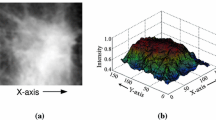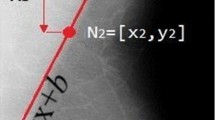Abstract
Cancerous mass detection methods for mammographic images still miss some malignant cases on the one hand, and produce too many false-positive (FP) detections with respect to the number of true-positive (TP) detections on the other. An attempt has been described to improve the TP ratio per image and to decrease the number of FP errors in the hierarchical template matching detector of regions of interest (ROIs) for cancerous masses by eliminating the images of linear structures (LSs) from the mammograms. The LSs were detected with an accumulation-based line detector. The measure of correctness of the ROIs detection was discussed and the quality of the detector, represented by free receiver operating characteristics curves, was compared with the human-eye observations. The result is that the widely used measure of detection correctness seems to underestimate the detection quality made by a human. Tests were performed on the mammograms from the MIAS database.











Similar content being viewed by others
Explore related subjects
Discover the latest articles, news and stories from top researchers in related subjects.References
Sampat MP, Markey MK, Bovik AC (2005) Computer-aided detection and diagnosis in mammography. In: Bovik AC (ed) Handbook of Image and video processing. Academic Press, New York, pp 1195–1217
Dziukowa J, Wesołowska E (eds) (2006) Mammography in breast cancer diagnosis (in Polish), 2nd edn. Medipage, Warszawa
Zwiggelaar R, Parr TC, Schumm JE et al (1999) Model-based detection of spiculated lesions in mammograms. Med Image Anal 3(1):39–62
Bator M, Nieniewski M (2006) The usage of template matching and multiresolution for detecting cancerous masses in mammograms. In: Piȩka E et al (eds) Proceedings of 11th international conference on medical informatics and technologies, Wisła-Malinka, Poland, pp 324–329
Kopans DB (1998) Breast imaging. Lippincott-Raven, Philadelphia
Thangavel K, Karnan M, Sivakumar R, Mohideen AK (2005) Automatic detection of microcalcifications in mammograms—a review. ICGST Int J Graph Vis Image Proc 05(V5):31–61
Hong B-W, Brady M (2003) Segmentation of mammograms in topographic approach. In: Proceedings of IEE international conference on visual information engineering VIE’03, Guildford
Zwiggelaar R, Astley SM, Boggis CRM, Taylor CJ (2004) Linear structures in mammographic images: detection and classification. IEEE Trans Med Imaging 23(9):1077–1086. doi:10.1109/TMI.2004.828675
Rangayyan RM, Ayres FJ (2006) Gabor filters and phase portraits for the detection of architectural distortion in mammograms. Med Bio Eng Comput 44(10):883–894. doi:10.1007/s11517-006-0088-3
Sheshadri HS, Kandaswamy A (2005) Detection of breast cancer tumor based on morphological watershed algorithm. ICGST Int J Graph Vis Image Proc 05(V5):17–21
Hadley EM, Denton ERE, Zwiggelaar R (2006) Mammographic risk assessment based on anatomical linear structures. In: Astley SM et al (eds) Proceedings of 8th international workshop digital mammography IWDM 2006, vol 4046 of LNCS, Manchester, Springer, Berlin, p 626–633. doi:10.1007/11783237_84
Hadley EM, Denton ERE, Zwiggelaar R et al (2007) Risk classification of mammograms using anatomical linear structure and density information. In: Proceedings of 3rd Iberian conference on pattern recognition and image analysis IbPRIA 2007, vol 4478 of LNCS, Girona, Springer, Berlin, pp 186–193. doi:10.1007/978-3-540-72849-8_24
Suckling J, Parker J, Dance D et al (1994) The mammographic images analysis society digital mammogram database. In: Gale AG, Astley SM, Dance DR et al (eds) Digital mammography, vol 1069 of Exerpta Medica International Congress Series, pp 375–378. http://www.wiau.man.ac.uk/services/MIAS/MIASweb.html; later moved to peipa.essex.ac.uk/info/mias.html
Chmielewski L (2006) Detection of non-parametric lines by evidence accumulation: finding blood vessels in mammograms. In: Proceedings of international conference on computer vision and graphics ICCVG 2004, Warsaw, Poland, Sep 22–24, 2004, vol 32 of computational imaging and vision, Springer, Berlin, pp 373–380. doi:10.1007/1-4020-4179-9_54
Chmielewski L (2005) Specification of the evidence accumulation-based line detection algorithm. In: Kurzyński M et al (eds) Computer recognition systems. Proceedings of international conference on computer recognition systems CORES 2005, vol 30 of Advances in Soft Computing, Rydzyna, Poland, 22–25 May 2005. Springer, Berlin, pp 355–362
Chmielewski LJ (2006) Fuzzy histograms, weak fuzzification and accumulation of periodic quantities. Application in two accumulation-based image processing methods. Patt Anal Appl 9(2–3):189–210. doi:10.1007/s10044-006-0037-7
Chmielewski LJ (2006) Evidence accumulation methods in digital image processing (in Polish). Akademicka Oficyna Wydawnicza EXIT, Warsaw. http://www.ippt.gov.pl/~lchmiel/akum06/
Bator M, Chmielewski LJ (2007) Elimination of linear structures as an attempt to improve the specificity of cancerous mass detection in mammograms. In: Kurzyński M et al (eds) Computer Recognition Systems 2. Proceedings of international conference on computer recognition systems CORES 2007, vol 45 of Advances in Soft Computing, Wrocław, 22–25 Oct 2007, Springer, Berlin, pp 596–603. doi:10.1007/978-3-540-75175-5_75
Sahiner B, Petrick N et al (2001) Computer-aided characterization of mammographic masses: accuracy of mass segmentation and its effects on characterization. IEEE Trans Med Imaging 20(12):1275–1284
Heath MK, Bowyer D, Kopans R et al (2000) The digital data base for screening mammography. In: Proceedings of 5th international workshop digital mammography, Toronto, pp 212–218. http://figment.csee.usf.edu/Mammography/DDSM
Bovis K, Singh S (2000) Detection of masses in mammograms using texture features. In: Proceedings of 15th international conference on pattern recognition (ICPR’00), vol 2, pp 2267–2270. doi:10.1109/ICPR.2000.906064
Cahoon TC, Suttoh MA, Bezdak JC (2000) Brest cancer detection using image processing techniques. In: Proceedings of 9th IEEE international conference on Fuzzy Systems 2000 FUZZ IEEE 2000, vol 2, pp 973–976
Li HD, Kallergi M, Clarke LP, Jain VK, Clark RA (1995) Markov random fields for tumor detection in digital mammography. IEEE Trans Med Imaging 14(3):565–576
Kobatake H, Murakami M, Takeo H, Nawano S (1999) Cmputerized detection of malignant tumors on digital mammograms. IEEE Trans Med Imaging 18(5):369–378
Zheng L, Chan AK (2001) An artificial intelligent algorithm for tumor detection in screening mammogram. IEEE Trans Med Imaging 20(7):559–567
Zheng L, Chan AK, McCord G et al (1999) Detection of cancerous masses for screening mammography using DWT based multiresolution Markov random fields. Technical report, Texas A&M University
Liu S, Babbs CF, Delp EJ (2001) Multiresolution detection of spiculated lesions in digital mammograms. IEEE Trans Image Proc 10(6):874–884
Christoyianni I, Dermatas E, Kokkinakis G (2000) Fast detection of masses in computer-aided mammography. IEEE Signal Proc Mag 17:54–64
Kegelmeyer WP, Pruneda JM, Bourland PD et al (1994) Computer-aided mammographic screening for spiculated lesions. Radiology 191:331–337
Lai S, Li X, Bishof WF (1989) On techniques for detecting circumscribed masses in mammograms. IEEE Trans Med Imaging 8(4):377–386
Li H, Wang Y, Ray Liu KJ et al (2001) Computerized radiographic mass detection—part II: decision support by featured database visualization and modular neural networks. IEEE Trans Med Imaging 20(4):302–313
Liu S (1999) The analysis of digital mammograms: spiculated tumor detection and normal mammogram characterization. Thesis, Purdue University
Heath M, Bowyer K (2000) Mass detection by relative image intensity. In: Proceedings of 5th international workshop on digital mammography, Toronto, Medical Physics Publishing, Madison, pp 219–225
Bornefalk H, Bornefalk Hermansson A (2005) On the comparison of FROC curves in mammography CAD systems. Med Phys 32(2):412–417. doi:10.1118/1.1844433
Wei J, Sahiner B, Hadjiiski LM et al (2005) Computer-aided detection of breast masses of full field digital mammograms. Med Phys 32(9):2827–2838
Sallam MY, Bowyer KW (1999) Registration and difference analysis of corresponding mammogram images. Med Image Anal 3(2):103–118
te Brake GM, Karssemeijer N (1999) Single and multiscale detection of masses in digital mammograms. IEEE Trans Med Imaging 18(7):628–639
Blake A, Zisserman A (1987) Visual reconstruction. MIT Press, Cambridge
Edwards DC, Kupinski MA, Metz CE, Nishikawa RM (2002) Maximum likelihood fitting of FROC curves under an initial-detection-and-candidate-analysis model. Med Phys 29(12):2861–2870
Acknowledgments
Author information
Authors and Affiliations
Corresponding author
Rights and permissions
About this article
Cite this article
Bator, M., Chmielewski, L.J. Finding regions of interest for cancerous masses enhanced by elimination of linear structures and considerations on detection correctness measures in mammography. Pattern Anal Applic 12, 377–390 (2009). https://doi.org/10.1007/s10044-008-0134-x
Received:
Accepted:
Published:
Issue Date:
DOI: https://doi.org/10.1007/s10044-008-0134-x




